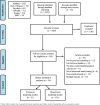The relationship between first-level leadership and inner-context and implementation outcomes in behavioral health: a scoping review
- PMID: 34229706
- PMCID: PMC8259113
- DOI: 10.1186/s13012-021-01104-4
The relationship between first-level leadership and inner-context and implementation outcomes in behavioral health: a scoping review
Abstract
Background: First-level leadership is uniquely positioned to support evidence-based practice (EBP) implementation for behavioral health due to first-level leaders' access to and relationship with service providers. First-level leaders are individuals who directly supervise and manage frontline employees who do not manage others. However, first-level leadership is underrepresented in existing reviews of the impact of leadership on EBP implementation. This review describes the relationship between first-level leadership and implementation determinants and outcomes.
Methods: A scoping review was performed to synthesize the literature on the relationship between first-level leadership and inner-context and implementation outcomes. A literature search was conducted in PubMed, Eric, PsycINFO, CINAHL, Scopus, and Web of Science. To be eligible, studies had to examine first-level leadership, be conducted in settings providing behavioral health services, and examine the relationship between first-level leadership and an implementation or inner-context outcome. Data extraction and synthesis were performed to describe study characteristics, leader-outcome relationships, and overlap in leadership frameworks.
Results: Twenty-one records met our inclusion criteria. Studies primarily relied on observational designs and were often cross-sectional. Studies more often examined general leadership rather than leadership strategically focused on EBP implementation (i.e., strategic implementation leadership). Our findings suggest that several forms of first-level leadership are inconsistently related to a broad set of implementation determinants, with infrequent examination of specific implementation outcomes. The broad set of implementation determinants studied, limited number of replications, and inconsistent findings have resulted in sparse evidence for any specific leadership-outcome relationship. The greatest accumulation of evidence exists for general leadership's positive relationship with providers' EBP attitudes, most notably in the form of transformational leadership. This was followed by evidence for strategic implementation leadership facilitating general implementation. Our synthesis revealed moderate conceptual overlap of strategic implementation leadership behaviors described in the theory of implementation leadership and theory of middle managers' role in implementation.
Conclusions: Our findings suggest that first-level leadership may play an important role in shaping implementation determinants and outcomes, but consistent empirical support is sparse and confidence dampened by methodological issues. To advance the field, we need studies that adopt stronger methodological rigor, address the conceptual overlap in leadership frameworks, examine a broader set of implementation outcomes, and examine conditions under which leadership impacts implementation.
Trial registration: This review was not registered.
Keywords: Behavioral health; First-level leadership; Implementation determinants; Implementation outcomes; Inner-context outcomes.
Conflict of interest statement
The authors declare that they have no competing interests.
References
-
- Weisz JR, Ng MY, Bearman SK. Odd couple? Reenvisioning the relation between science and practice in the dissemination-implementation era. Assoc Psychol Sci. 2016;2(1):58–74.
Publication types
MeSH terms
Grants and funding
LinkOut - more resources
Full Text Sources
Miscellaneous

